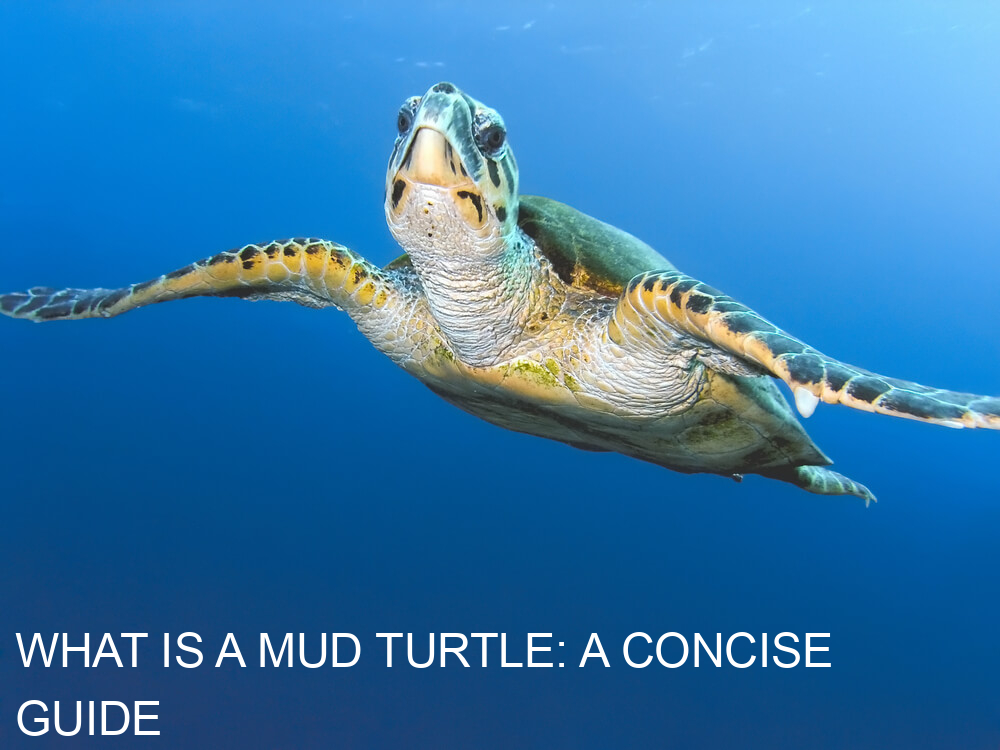Mud turtles are interesting and somewhat lesser-known species of turtle that inhabit various freshwater environments such as swamps, ponds, and marshes. With their small size and distinct appearance, they make for fascinating subjects of study for both scientists and pet enthusiasts.
What is a Mud turtle, you ask? These turtles belong to the Kinosternidae family and are primarily found in the Americas, from the United States to South America.
They are known for their unique physical attributes, such as their domed shell, relatively small size compared to other turtles, and webbed feet.
Adapting to their environment, mud turtles have developed behavioral characteristics that allow them to thrive in the muddy and shallow waters they inhabit.
Key Takeaways
- Mud turtles are small freshwater turtles found in the Americas.
- They have unique physical attributes like a domed shell and webbed feet.
- Their behavioral characteristics have adapted to their muddy, shallow water habitats.
What Is A Mud Turtle?
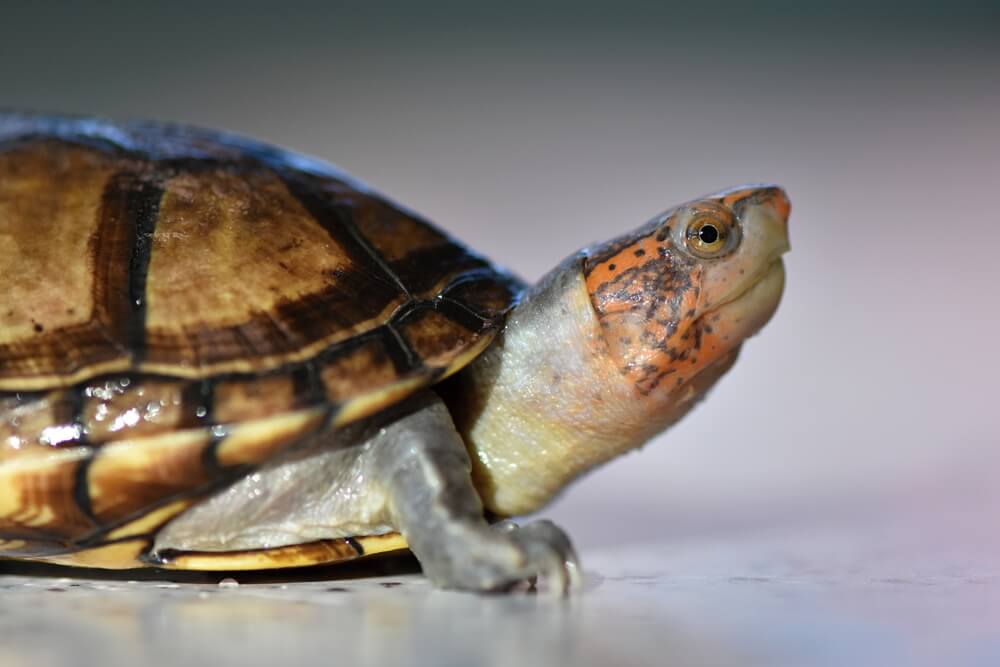
I am excited to discuss mud turtles, which belong to the genus Kinosternon within the larger family Kinosternidae.
As members of the class Reptilia and the order Testudines, mud turtles are intriguing creatures that are typically found in aquatic environments.
There are several distinct species of mud turtles, such as the Eastern mud turtle (Kinosternon subrubrum), striped mud turtle, Mississippi mud turtle, and yellow mud turtle. Among these, the Kinosternon subrubrum is particularly fascinating.
With its characteristic small size and easily distinguishable appearance, subrubrum is quite popular among turtle enthusiasts.
Inhabiting a variety of aquatic habitats within North and Central America, mud turtles have adapted well to their surroundings. They can be found in freshwater environments like ponds, marshes, and slow-moving streams.
Their unique classification within the family Kinosternidae and genus Kinosternon sets them apart from other turtle species.
In terms of appearance, mud turtles have a rather distinctive look. They generally have a dark, oval carapace (upper shell) and a yellow or brown plastron (lower shell).
Interspecies variations can also occur, such as the striped mud turtle, which boasts bold yellow stripes that contrast against its dark carapace.
Despite their small size and seemingly unassuming nature, mud turtles are known to be quite hardy and resilient creatures.
Their incredible adaptability makes them an interesting topic for further study, and they serve as a great example of the diversity and adaptiveness found within the world of reptiles.
Geographical Distribution

I am aware that mud turtles are primarily found in North America, particularly the United States, as well as parts of South America. Their habitats vary, and they can thrive in various environments such as swamps, ponds, marshes, and slow-moving rivers.
As a knowledgeable person in this subject, I must mention that mud turtles are well-adapted to their aquatic habitats. They are adept at swimming and can often be found basking on logs and vegetation or simply floating at the water’s surface.
Not all mud turtles are alike, as different species have their own unique ranges and preferences.
For instance, the Eastern mud turtle (Kinosternon subrubrum) is native to the eastern United States, while the yellow mud turtle (Kinosternon flavescens) is found in the central United States down into Mexico.
There’s also the striped mud turtle (Kinosternon baurii), which is endemic to the southeastern United States.
In South America, we can find species such as the Amazon mud turtle (Kinosternon scorpioides), which is native to the Amazon Basin and other regions of northern South America.
The white-lipped mud turtle (Kinosternon leucostomum) is another example of a South American mud turtle species, found from southern Mexico to Colombia and Venezuela.
I can confidently state that mud turtles have a wide geographical distribution that encompasses various habitats throughout North and South America, making them an interesting and adaptable group of aquatic reptiles.
Physical Attributes
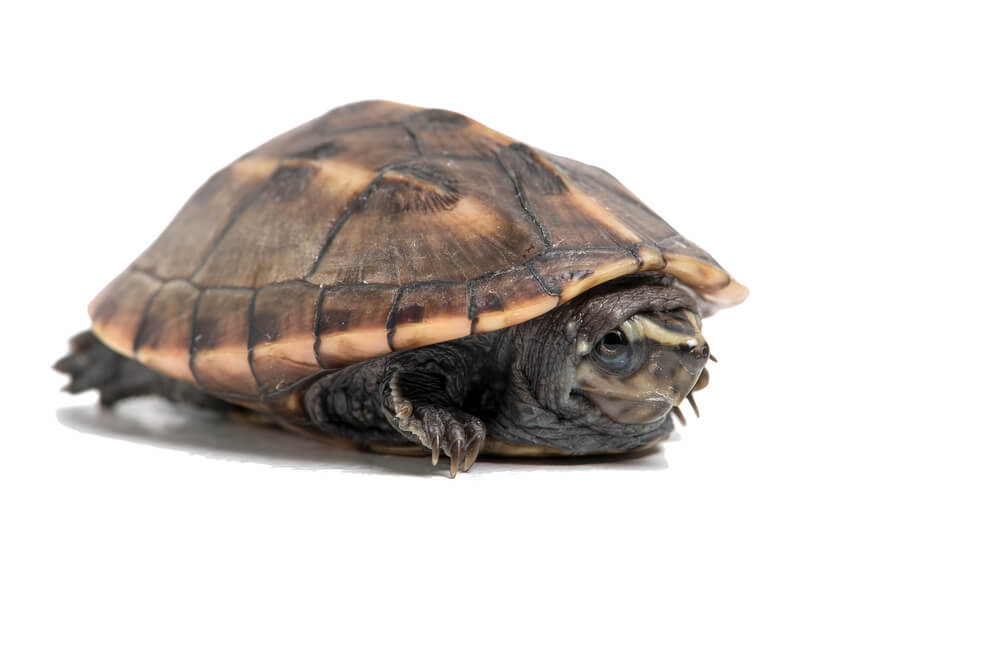
I have observed that mud turtles belong to the aquatic species, thriving in both freshwater and brackish environments. Their size varies, but on average, they measure about 5 inches in carapace length.
The carapace, or the upper shell, exhibits colors ranging from light brown to dark brown, often with yellow markings that add to their distinctive appearance.
In addition to the carapace, the plastron, or the lower shell, is another characteristic feature of mud turtles. The plastron is usually lighter in color than the carapace, sporting a combination of yellow and brown hues.
The plastron serves as protection for the turtle’s underside, enabling it to thrive in various environments confidently.
To enhance the reader’s comprehension of mud turtles’ physical attributes, let me summarize:
- Aquatic species found in freshwater and brackish environments
- Average size of 5 inches in carapace length
- Carapace color varies from light to dark brown with yellow markings
- Plastron is lighter in color, usually featuring yellow and brown hues
- Plastron offers protection for the turtle’s underside
Given their unique physical attributes, mud turtles are easily identifiable among other turtle species, allowing enthusiasts and researchers like me to study them in-depth.
Behavioral Characteristics
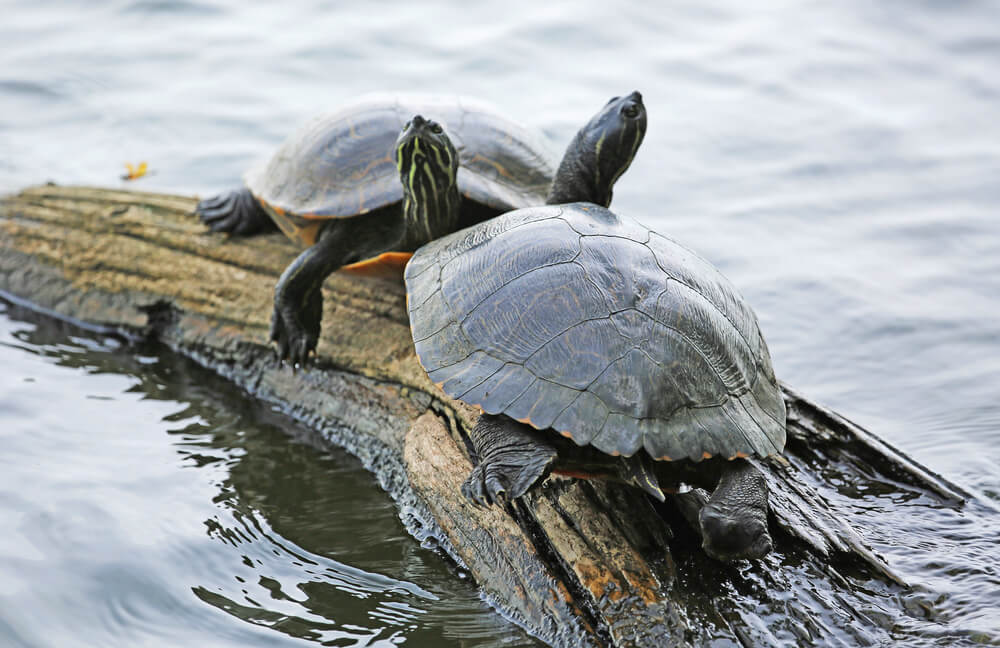
As a mud turtle, I am an aquatic species that spends most of my life in or near water. My behavior is influenced by various factors, including food, environment, and temperature.
I must say that I am omnivorous, which means that my diet consists of both plants and small animals.
I prefer to dine on aquatic plants, mollusks, crustaceans, insects, and even fish. Although I am not a picky eater, I make sure to balance my diet between plant matter and animal protein.
In terms of where I live, I am primarily found in slow-moving water bodies with muddy bottoms, which allows me to demonstrate my superb burrowing skills.
I dig into the mud to rest, hide from predators, and hibernate during the colder months.
My swimming capability is quite remarkable. With strong limbs and webbed feet, I can easily glide through water. Also, I am an excellent diver, which aids me in hunting and escaping from potential threats.
One interesting behavioral aspect of mine is basking. Even though I am an aquatic turtle, I appreciate spending some time basking on logs, rocks, or other surfaces close to the water.
This activity helps me regulate my body temperature, maintain good health, and digest my food more effectively.
My temperament is generally mild, but it is essential to know that I can bite when I feel threatened. For a small turtle like me, having a defense mechanism like this is crucial for survival.
Nevertheless, I do not display aggressive behavior unless I consider it necessary for my safety.
During the winter months, I hibernate to conserve energy and adapt to the colder temperatures. My hibernation process usually involves burrowing into the mud at the bottom of my aquatic habitat.
This is an essential part of my life cycle that allows me to survive harsh conditions.
In summary, my life as a mud turtle consists of various behavioral characteristics, such as being omnivorous, swimming, diving, burrowing, having a relatively mild temperament but being able to bite when necessary, and hibernating in the winter.
These traits help make me the fascinating creature that I am.
Diet and Feeding
As someone who is knowledgeable about mud turtles, I can tell you that their diet is diverse and satisfying.
I’ve noticed that these little reptiles have a healthy appetite for various aquatic food sources, which I’ll detail below in a neatly organized list.
- Fish: I’ve often seen mud turtles munch on small fish and fish eggs. They prefer slow-moving or injured fish, which are easier to catch.
- Worms: Earthworms are a favorite food of mud turtles, and I’ve witnessed them devouring these squirmy creatures on numerous occasions.
- Insects: Insects such as dragonfly larvae, beetles, and moths constitute a significant part of the mud turtle’s diet. They are always on the lookout for these tasty morsels.
- Snails: Mud turtles enjoy feeding on various snail species, cracking their shells with powerful jaws.
- Algae: While not a primary food source, mud turtles do occasionally consume algae as part of their diet.
- Arthropods: I’ve observed that mud turtles like to feed on arthropods, such as crayfish and shrimp, which typically inhabit the same watery environments.
- Carrion: These opportunistic feeders aren’t picky and will also happily eat dead animals when available.
- Plants: As omnivores, mud turtles consume aquatic plants as part of their diet. They prefer tender leaves and shoots over fibrous, mature plants.
From my experience, I can confidently say that mud turtles are efficient feeders. They use their sharp beaks and strong jaws to pierce and tear apart their food.
Their varied diet keeps them healthy and ensures that they adapt well to different environments.
Captive Care
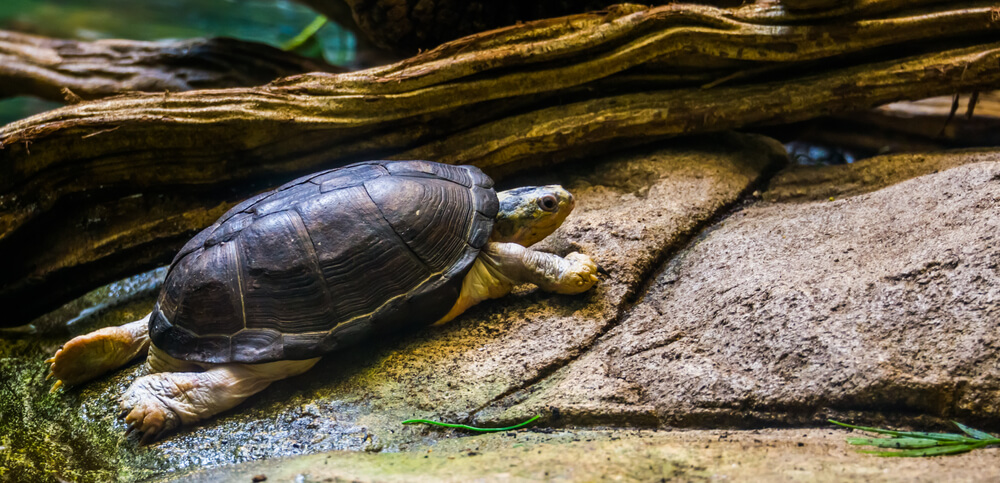
When I decide to keep a mud turtle as a pet, proper housing and care are crucial to ensure the turtle’s well-being. I always make sure to provide an adequately sized tank for my mud turtle. Ideally, a 30 to 50-gallon tank works well for an adult mud turtle.
I keep at least half of the tank filled with water, while the rest should be a dry basking area.
For optimal water quality, I use a good filtration system to keep my turtle’s environment clean. I also ensure that the water temperature remains consistent between 72°F to 76°F. To maintain the desired temperature, I use an aquarium heater.
It’s important for me to create a suitable substrate in the aquatic section of the tank. I tend to use a mix of fine gravel and aquarium-safe sand to allow my mud turtle to burrow and stay comfortable.
In the basking area, I provide flat rocks or a turtle dock. This allows my turtle to rest, bask, and regulate its body temperature.
Mud turtles require heat and light to remain healthy in captivity. I use both heat and UVB lamps to mimic their natural environment and provide them with vital energy.
The basking area should have a temperature of around 90°F. I also make sure to change the UVB bulb every six months to ensure my turtle receives adequate levels of ultraviolet light.
Proper diet is another essential aspect of captive care for mud turtles. I feed my turtle a well-balanced diet consisting of commercial aquatic turtle pellets, leafy greens, insects, and the occasional fish.
I also offer a calcium supplement to ensure my turtle has strong and healthy bones and shells.
By adhering to these guidelines, I can provide a comfortable and healthy environment for my mud turtle to thrive in captivity.
It’s important for me, as a responsible turtle owner, to regularly monitor the tank conditions and maintain the highest level of care for my pet.
Reproduction
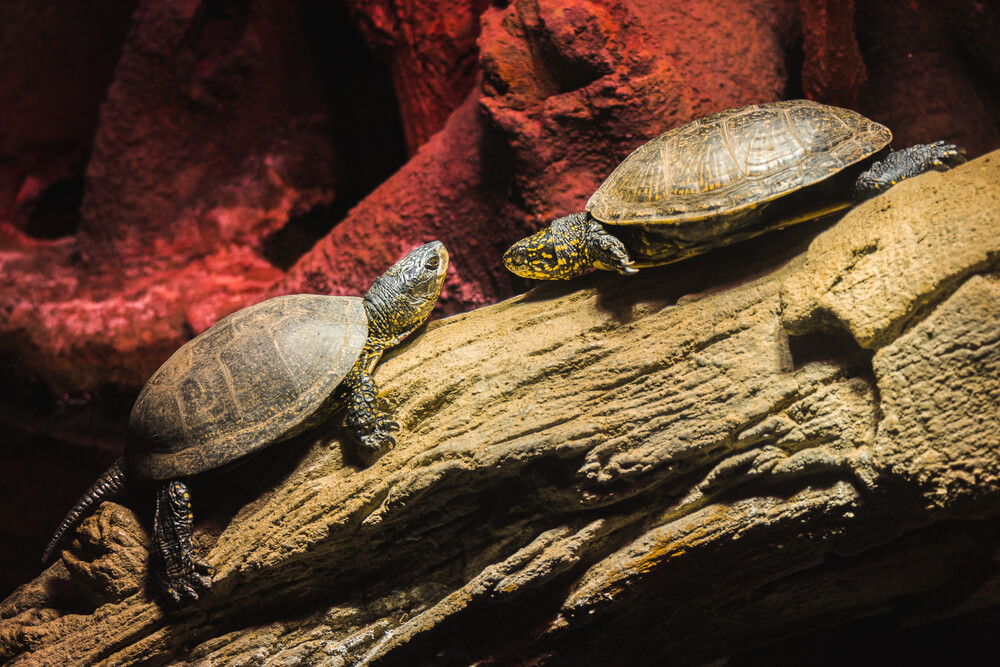
I have observed that mud turtles are fascinating creatures when it comes to their reproduction. When a female mud turtle is ready to lay her eggs, she will typically search for a suitable nesting site with loose soil or sand, allowing her to easily dig a cavity.
Once she has found the perfect spot, she can lay a clutch of eggs that varies in size, depending on the species. Some species lay only a couple of eggs, whereas others can lay up to a dozen.
The incubation period for mud turtle eggs spans anywhere from 45 to 90 days, but this largely depends on external factors such as weather conditions and temperature.
Interestingly, the sex of the hatchlings is determined by the temperature during incubation. Higher temperatures typically result in a greater number of females, whereas lower temperatures produce more males.
As the eggs hatch, the tiny hatchlings emerge, each equipped with a small egg tooth that helps them break through the eggshell. At this stage, the hatchlings are vulnerable to predators like raccoons, birds, and fish.
Yet, with their keen survival instincts, these young mud turtles will quickly learn how to navigate their way through their environment, blending in with their surroundings and employing their unique defense mechanisms.
Caring for the young mud turtles is a task predominantly handled by the females. They display a remarkable level of parental care, guarding their nests attentively and even aiding their hatchlings in escaping the confines of their eggs.
In my experience, mud turtle reproduction is an incredible natural process that highlights the tenacity and perseverance of these fascinating reptiles.
Adapting to various conditions and nurturing their young, they serve as a testament to the resilience of life itself.
Relation to Other Species
As a member of the Kinosternidae family, I share close relationships with several species of turtles and even some amphibians. My cousins, the musk turtles, belong to the Sternotherus genus.
We have some similarities, like our small size and preference for slow-moving waters.
Musk turtles, sometimes referred to as “stinkpots,” secrete a musky odor when they feel threatened. While I don’t have this distinct feature, my name, “mud turtle,” comes from my habit of burying myself in the mud or under aquatic vegetation for protection.
This shared instinct for self-preservation demonstrates our shared ancestry.
When it comes to our interactions with pets and humans, we both can make excellent choices for older children and adults who seek a unique, low-maintenance companion.
But, like any pet, we require proper care to ensure our health and happiness. It’s important to keep our habitats clean and closely monitor water quality, as poor conditions may lead to common issues among aquatic pets like shell infections or itch.
Overall, the Kinosternidae family encompasses diverse species with unique traits and habits. Our adaptations make us well-suited to our respective environments and beloved by those who care for us as pets.
Conservation
In my experience, mud turtles are found in various habitats, such as fields, streams, and marshes. Over the past 50 years, their populations have faced numerous challenges like habitat destruction, pollution, and pet trade.
As a result, the conservation status of these remarkable creatures has become a cause for concern.
When it comes to protecting mud turtles and their ecosystems, there are several measures that can be taken. For instance, maintaining clean water sources in their habitats is vital, as water pollution has adverse effects on their health.
Similarly, restricting the pet trade can reduce the number of turtles removed from their natural environments.
Conservationists should also work to restore damaged habitats, thereby providing mud turtles with better living conditions and enhancing their chances of survival.
As conservation efforts continue, the importance of educating the public about mud turtles cannot be overstated. By raising awareness about these fascinating animals, their habitats, and the challenges they face, we can foster greater understanding and appreciation for mud turtles.
In turn, this should encourage better decision-making related to their protection and conservation.
In a nutshell, conserving mud turtle populations will necessitate a multi-faceted approach.
Implementing habitat restoration, pollution control, and public education efforts can address the various threats to these reptiles and ensure their survival for future generations.
In doing so, we can maintain a healthy and balanced ecosystem.
Health Considerations
I have found that there are some important health considerations to keep in mind when caring for a mud turtle. First and foremost, these turtles are prone to respiratory infections.
To help prevent this, maintaining a clean and dry environment is crucial, including proper water filtration and frequent substrate cleaning.
These reptiles need a basking area with a UVB heat lamp to provide warmth and encourage their immune system.
Mud turtles like K. baurii may undergo dormancy or brumation, especially if they experience a drop in temperature. Although it is a natural behavior, it can pose health risks.
During dormancy, the turtle’s immune system can weaken, making it more susceptible to diseases. To avoid health complications, I monitor the temperature of their habitat and ensure it remains stable.
Furthermore, the diet plays a significant role in the health of mud turtles. I provide a balanced diet of high-quality commercial turtle pellets, supplemented with live food like worms, insects, and small fish.
Offering adequate nutrition not only ensures good health but may also help prevent conditions such as Metabolic Bone Disease.
I suggest keeping a close eye on your mud turtle for any signs of illness, such as lethargy, decreased appetite, unusual shell growth, or discharge around the eyes and nose.
In case of any concerns, I recommend consulting a vet experienced with reptiles as soon as possible.
Frequently Asked Questions
How big do Mississippi mud turtles grow?
Mississippi mud turtles typically grow to a length of 3 to 5 inches (7.5 to 12.5 cm). They have a dark brown, keel-like carapace, and a light-colored plastron. The head is brown, with a yellowish-green stripe running along the sides.
What is the ideal habitat for keeping a mud turtle as a pet?
To create an ideal habitat for a mud turtle, I recommend providing a 20 to 40-gallon tank with a water depth of 6 to 12 inches. A basking area with a heat lamp should be provided, as well as hiding spots and a water filtration system.
The tank’s temperature should be maintained at around 75 to 85°F (24 to 30°C) during the day and slightly cooler at night.
What do mud turtles eat in captivity?
In captivity, mud turtles primarily consume a diet of small aquatic invertebrates, such as worms, snails, insects, and crustaceans. Offering commercial turtle pellets can provide additional nutrients.
It’s important to supplement their diet with occasional leafy greens and vegetables for proper nutrition.
Is there a difference between mud turtles and snapping turtles?
Yes, there is a difference between mud turtles and snapping turtles. Mud turtles are generally smaller, less aggressive, and have a more streamlined shell compared to snapping turtles.
Snapping turtles have a large head, powerful jaws, and a more robust body structure, making them potentially dangerous if handled improperly.
What are the key features of a striped mud turtle?
The striped mud turtle is characterized by three distinct light yellowish-brown stripes running along its dark brown carapace. The plastron is typically yellowish to light brown.
They generally have a small size, growing between 3 to 4.5 inches (7.5 to 11.5 cm) in length.
How to properly care for an Eastern mud turtle?
To properly care for an Eastern mud turtle, it’s essential to provide a suitable habitat that includes a shallow water area and a dry basking area with a heat lamp. A water filtration system is necessary to maintain water quality.
They should be fed a diet of small aquatic invertebrates, commercial turtle pellets, and occasional leafy greens and vegetables.
Regularly monitoring the turtle’s health and tank conditions is crucial for its well-being.

